MoonShadows
Almost Self-Reliant
I found this article at AskAPrepper.com and found it interesting. Water storage is the #1 consideration for any emergency, particularly long term. How we store our water for any long term emergency and/or how we plan to obtain our water for any long term emergency could mean the difference between life and death.
In any emergency situation water is going to be at the top of your priority list. Without water, your survival chances are measured in days – and not many of them. It’s vital that you have access to a reliable supply of clean, safe water. How much? At a minimum, a gallon a day for everyone in your group for a period of at least two weeks. For a family of four that means 56 gallons of water, and that’s a bare minimum. When you have to use it for drinking, cooking and washing, a gallon of water isn’t a lot.
Stashing a few extra bottles of Highland Spring in the fridge obviously isn’t going to cover your water needs for long, so for real preparedness you need to lay in a good supply. That means selecting suitable containers, filling them with safe water and storing them in a cool, dark dry place. Do that properly and you’ll have a water reserve that will keep you in the game until you can find a safe source, whether that’s a well, a rainwater catchment system or something else. Unfortunately, there’s a lot of bad advice floating around when it comes to storing water.
Here are some of the common myths, and the facts behind them:
Myth #1 – “I don’t need water storage because I have access to a well/pond/river”
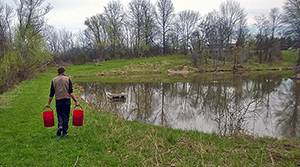
Some people believe that, because there’s a plentiful supply of water close by, they don’t need to keep an emergency stockpile. It’s easy to see the logic in this. After all, if you have a pond on your property with a few thousand gallons of water in it, what’s the point in stashing some barrels in the basement? If your regular water supply is from a well, you’re independent of the grid anyway and don’t need to take any extra precautions.
The logic is pretty clear – but it’s wrong. You don’t know what form an emergency will take. What if a nuclear power station has a containment failure and your pond gets lightly sprinkled with radioactive dust? You won’t want to go outside at all until the radiation level has fallen – which probably means a couple of weeks – and even if you could get at your water supply, it’s going to be contaminated. Fallout can be removed by filtering, but you end up with a radioactive filter. Your well? That could be contaminated by fracking, or even leached chemicals from an industrial accident.
In a SHTF scenario, rivers and ponds are going to be a magnet for less prepared people. You can’t safely rely on them in the short term. To be safe, you need to have a supply of water that you control access to and know was safe when it was stored.
Myth #2 – “A water tank or stash of barrels will leave me prepared for anything”
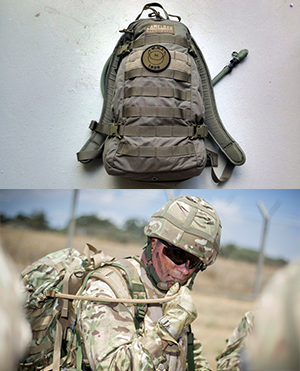
Storage tanks, barrels or five gallon containers are all great solutions for bulk water storage. If you want to have a few hundred gallons of safe water to hand, large containers are the way ahead. Many preppers believe this is all they need to keep them going until they can set up some way to collect safe water from a sustainable source.
What if you have to move, though? You keep a bug-out bag, stocked with food, ammunition and medical supplies. Are you planning to take water, too? You need to be, because it’s just as essential when you’re on the move – but you can’t take a 55-gallon drum with you.
A couple of five gallon containers will do well if you’re leaving by vehicle, but the worst case scenario is you’ll have to bug out on foot. If that happens you’ll need water containers you can take with you. A Camelbak or similar hydration system is a great idea, especially if you’re moving on foot in hot weather. It isn’t enough though, so carry military water bottles as well – a couple of one-quart canteens will be a useful extra reserve.
Myth #3 – “Water will deteriorate in storage”
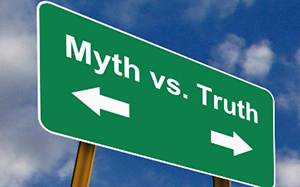
It’s a good idea to have a decent supply of water that’s kept fresh. For example you can have one or two five-gallon jerrycans that are emptied, rinsed and refilled every month. That gives you a few days’ supply that can be drunk straight out the container. There’s no need to worry about bulk storage, though. Water doesn’t deteriorate. It’s H20 and that’s that. You can store water for years and it will still be just as capable of hydrating you.
On the other hand, after long-term storage it might not be fit to drink straight away. Microorganisms can grow in it, especially if the containers weren’t sterile when you filled them. That doesn’t mean you need to throw it out though. It can be made safe by boiling, filtering or chemical purification, just like water from any other source. In The Lost Ways you can find a chapter detailing the procedure of sterilizing containers and storing water long term.
The advantage is that because you know it was safe when you stored it, there’s no risk of it being contaminated by chemicals, animal feces or any other hazard – you just need to kill anything that’s grown in it.
Myth #4 – “Water needs to be treated before storage”
There’s a common belief that water needs to be treated before it’s stored. This isn’t true at all. Tap water almost anywhere in the USA is perfectly safe, so there’s no point in doing anything when you fill the containers. After the filtering and purification it got at the water treatment plant, it’s clean enough for storage.
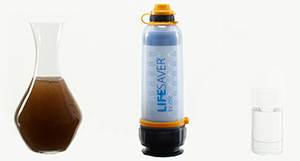
Also keep in mind that even if you purify the water before storing it, over a long period microorganisms can still grow in it. Chemical purifiers will last a while, but in the end they’ll evaporate. If water has been stored for months or years you should treat it before use, so why waste time and money treating it before storage? You’ll have to do it again later, anyway, so you might as well cut out the duplication and just do it when necessary.
If water’s dirty or has a lot of growth in it, chemical purification isn’t really enough – you should filter it, too. If you get a high efficiency filter chemicals won’t even be needed. Something like a Lifesaver filter will remove microorganisms with over 99.99% efficiency, as well as clearing out any dirt, debris and suspended pollution. Again, though, do that before you use the water, not before you store it.
Myth #5 – “Water can be stored in any container”
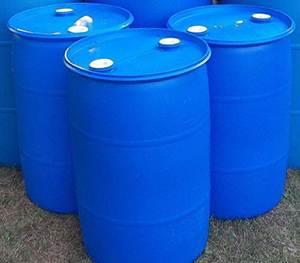
In a real emergency situation, any clean container can be used for short term water storage. For long term storage, however, you need to be a bit more selective. A lot of disposable plastic containers, like milk jugs, aren’t designed for long term use. Many of them are now biodegradable, so they’ll start to break down after a few months.
As they do that chemicals will dissolve into the water, and while they’re probably not going to poison you it makes sense to avoid them. Eventually these containers will start to leak, and you’ll lose your water. Disposable water or soda bottles are a bad idea, too. They’re clear, and let light through; light encourages microorganisms to grow.
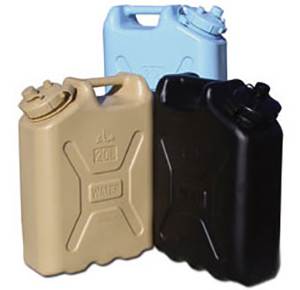
The ideal storage containers are plastic barrels molded from food-grade polyethylene. The normal color for water barrels is blue; this blocks most of the light, and what it does let through is in wavelengths that tend to slow down bacteria and algae instead of encouraging them.
Military water containers are also good; these are totally opaque, so no light gets in at all. Picking solid, good quality food grade containers will help keep your water supply safe in the long term.
In any emergency situation water is going to be at the top of your priority list. Without water, your survival chances are measured in days – and not many of them. It’s vital that you have access to a reliable supply of clean, safe water. How much? At a minimum, a gallon a day for everyone in your group for a period of at least two weeks. For a family of four that means 56 gallons of water, and that’s a bare minimum. When you have to use it for drinking, cooking and washing, a gallon of water isn’t a lot.
Stashing a few extra bottles of Highland Spring in the fridge obviously isn’t going to cover your water needs for long, so for real preparedness you need to lay in a good supply. That means selecting suitable containers, filling them with safe water and storing them in a cool, dark dry place. Do that properly and you’ll have a water reserve that will keep you in the game until you can find a safe source, whether that’s a well, a rainwater catchment system or something else. Unfortunately, there’s a lot of bad advice floating around when it comes to storing water.
Here are some of the common myths, and the facts behind them:
Myth #1 – “I don’t need water storage because I have access to a well/pond/river”

Some people believe that, because there’s a plentiful supply of water close by, they don’t need to keep an emergency stockpile. It’s easy to see the logic in this. After all, if you have a pond on your property with a few thousand gallons of water in it, what’s the point in stashing some barrels in the basement? If your regular water supply is from a well, you’re independent of the grid anyway and don’t need to take any extra precautions.
The logic is pretty clear – but it’s wrong. You don’t know what form an emergency will take. What if a nuclear power station has a containment failure and your pond gets lightly sprinkled with radioactive dust? You won’t want to go outside at all until the radiation level has fallen – which probably means a couple of weeks – and even if you could get at your water supply, it’s going to be contaminated. Fallout can be removed by filtering, but you end up with a radioactive filter. Your well? That could be contaminated by fracking, or even leached chemicals from an industrial accident.
In a SHTF scenario, rivers and ponds are going to be a magnet for less prepared people. You can’t safely rely on them in the short term. To be safe, you need to have a supply of water that you control access to and know was safe when it was stored.
Myth #2 – “A water tank or stash of barrels will leave me prepared for anything”

Storage tanks, barrels or five gallon containers are all great solutions for bulk water storage. If you want to have a few hundred gallons of safe water to hand, large containers are the way ahead. Many preppers believe this is all they need to keep them going until they can set up some way to collect safe water from a sustainable source.
What if you have to move, though? You keep a bug-out bag, stocked with food, ammunition and medical supplies. Are you planning to take water, too? You need to be, because it’s just as essential when you’re on the move – but you can’t take a 55-gallon drum with you.
A couple of five gallon containers will do well if you’re leaving by vehicle, but the worst case scenario is you’ll have to bug out on foot. If that happens you’ll need water containers you can take with you. A Camelbak or similar hydration system is a great idea, especially if you’re moving on foot in hot weather. It isn’t enough though, so carry military water bottles as well – a couple of one-quart canteens will be a useful extra reserve.
Myth #3 – “Water will deteriorate in storage”

It’s a good idea to have a decent supply of water that’s kept fresh. For example you can have one or two five-gallon jerrycans that are emptied, rinsed and refilled every month. That gives you a few days’ supply that can be drunk straight out the container. There’s no need to worry about bulk storage, though. Water doesn’t deteriorate. It’s H20 and that’s that. You can store water for years and it will still be just as capable of hydrating you.
On the other hand, after long-term storage it might not be fit to drink straight away. Microorganisms can grow in it, especially if the containers weren’t sterile when you filled them. That doesn’t mean you need to throw it out though. It can be made safe by boiling, filtering or chemical purification, just like water from any other source. In The Lost Ways you can find a chapter detailing the procedure of sterilizing containers and storing water long term.
The advantage is that because you know it was safe when you stored it, there’s no risk of it being contaminated by chemicals, animal feces or any other hazard – you just need to kill anything that’s grown in it.
Myth #4 – “Water needs to be treated before storage”
There’s a common belief that water needs to be treated before it’s stored. This isn’t true at all. Tap water almost anywhere in the USA is perfectly safe, so there’s no point in doing anything when you fill the containers. After the filtering and purification it got at the water treatment plant, it’s clean enough for storage.

Also keep in mind that even if you purify the water before storing it, over a long period microorganisms can still grow in it. Chemical purifiers will last a while, but in the end they’ll evaporate. If water has been stored for months or years you should treat it before use, so why waste time and money treating it before storage? You’ll have to do it again later, anyway, so you might as well cut out the duplication and just do it when necessary.
If water’s dirty or has a lot of growth in it, chemical purification isn’t really enough – you should filter it, too. If you get a high efficiency filter chemicals won’t even be needed. Something like a Lifesaver filter will remove microorganisms with over 99.99% efficiency, as well as clearing out any dirt, debris and suspended pollution. Again, though, do that before you use the water, not before you store it.
Myth #5 – “Water can be stored in any container”

In a real emergency situation, any clean container can be used for short term water storage. For long term storage, however, you need to be a bit more selective. A lot of disposable plastic containers, like milk jugs, aren’t designed for long term use. Many of them are now biodegradable, so they’ll start to break down after a few months.
As they do that chemicals will dissolve into the water, and while they’re probably not going to poison you it makes sense to avoid them. Eventually these containers will start to leak, and you’ll lose your water. Disposable water or soda bottles are a bad idea, too. They’re clear, and let light through; light encourages microorganisms to grow.

The ideal storage containers are plastic barrels molded from food-grade polyethylene. The normal color for water barrels is blue; this blocks most of the light, and what it does let through is in wavelengths that tend to slow down bacteria and algae instead of encouraging them.
Military water containers are also good; these are totally opaque, so no light gets in at all. Picking solid, good quality food grade containers will help keep your water supply safe in the long term.


 Candles, matches, lamps & oil, conserve water, etc., to get you to think about what you really need to do, use, salvage.
Candles, matches, lamps & oil, conserve water, etc., to get you to think about what you really need to do, use, salvage.